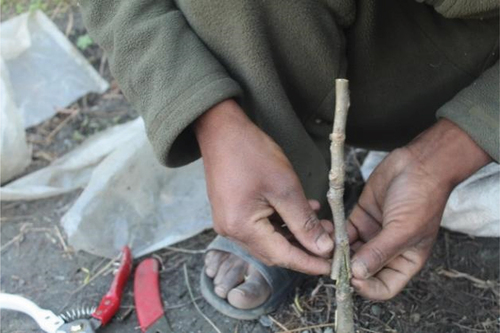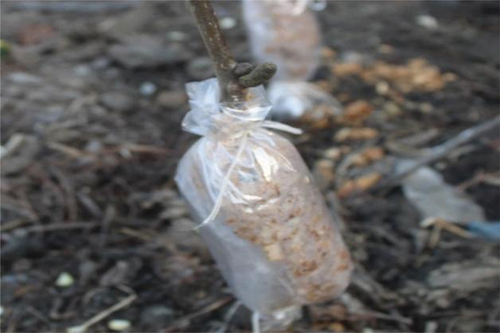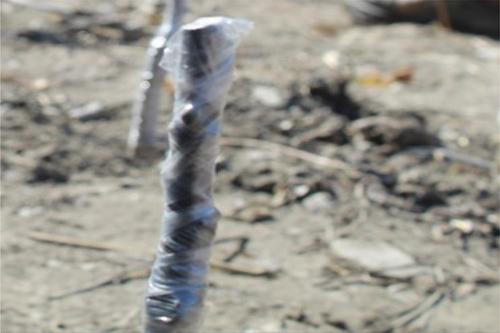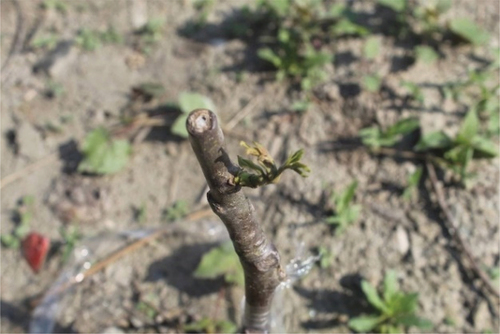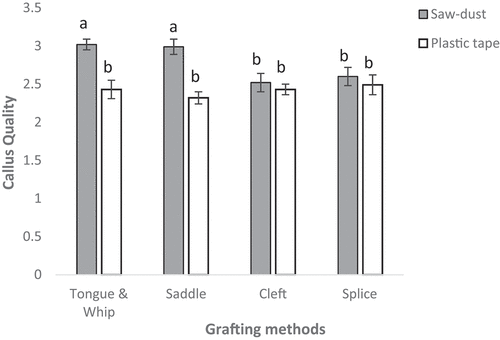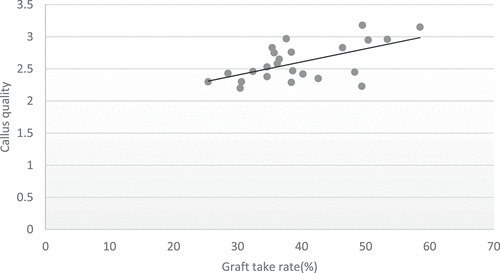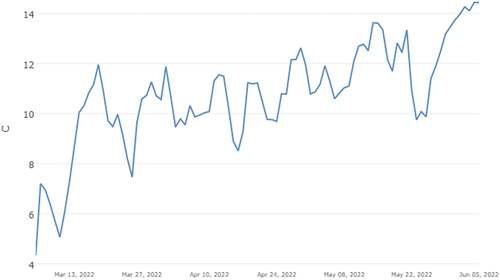Abstract
Walnut carries a great potential for cultivation in the high hills of Nepal, including the Mugu district. However, progress has not been as expected. Low graft survival rate and poor grafting practices account for inadequate number of quality saplings and consequently unreasonable price for successful ones. In this context, a field-based research was conducted in a two-factorial Randomized complete block design (RCBD) at Chhayanath Rara, 03, Mugu, to determine the suitable grafting method and covering material for grafting in walnut. Four different grafting methods viz. Tongue, saddle, cleft, and splice along with sawdust and grafting tape as graft covers were employed as treatments. The tongue grafting method yielded the highest callused rate (68.07%) and the highest graft take rate (48.07%). Similarly, sawdust used as a graft cover produced the most promising results on both the callused rate (56.37%) and the graft take rate (44.27%). Furthermore, the use of sawdust cover was found to have a greater callus quality (2.78) compared to that of using a grafting tape. No statistical differences were obtained in saleable plant rate and days to bud burst as a result of either of the factors. Apart from callus quality, the interaction between the two factors did not produce considerable variation in any of the variables. Hence, this study suggests the application of the tongue grafting method, along with the use of sawdust as a graft cover for enhanced grafting performance in agro-climatic zones similar to Mugu.
1. Introduction
Walnut is a deciduous fruit tree in the Juglandaceae family that grows best in temperate climatic regions (McGranahan & Leslie, Citation2012). Among many reported species, the species grown for the commercial production of walnuts globally is the Persian walnut (Juglans regia L.). Studies suggest walnut is a native to the highlands of southeastern Europe and west-central Asia, including Nepal (Pollegioni et al., Citation2014). The wild form of walnut (Juglans regia var. kamaonia Nepali, Local name: Hade okhar) is found abundantly in the mixed deciduous forests of Nepal (Chalise et al., Citation2021). In Nepal, walnut carries cultural significance in festivals and is popular by the local name “Okhar” (Gautam et al., Citation2020).
Propagation in walnuts can be carried out either by seed propagation or by asexual methods. Propagation via seed results in variability in the progeny, an extended juvenile period of the plants, and large tree sizes (Lloyd, Citation1980; Sallom et al., Citation2022). So, the vegetative methods of propagation must be followed, as they shorten the time to bearing and allow the development of true-to-type plants (Dawson, Citation1995). As methods like layering and cutting in walnut are not very effective (Vahdati et al., Citation2022), grafting is the most widely followed method of vegetative reproduction in walnut. Grafting success in walnut has been reported to vary due to a variety of factors, including different grafting methods (Achim & Botu, Citation2001; Soleimani et al., Citation2005), time of grafting (Ahmed et al., Citation2012; Thapa et al., Citation2021) scion cultivars (Dehghan et al., Citation2009; Sharma et al., Citation2022) and covering materials (Aytekin Polat & Öztürk Ördek, Citation2008; Paunović et al., Citation2011). Furthermore, Karadeniz (Citation2005) concluded that climatic factors also play an important role in determining grafting efficiency in walnut. Temperature and humidity are the important climatic variables influencing callus quality, graft take, and graft survival; thus, temperature of 27°C and relative humidity of 80–90% are most favorable for grafting in walnut (Mostakhdemi et al., Citation2022; Vahdati & Zareie, Citation2006). Grafting survival in walnut is lower than in other temperate fruits; this is due to a higher rate of xylem bleeding, an excess phenol (juglone) content, and a necessity of higher critical moisture content for callus formation (Rongting & Pinghai, Citation1990). Profuse phenol content in walnut is responsible for low graft survival in walnut because phenol oxidation, together with protein accumulation, results in insoluble polyphenols in the form of a necrotic layer in the grafting of walnut (Rongting & Pinghai, Citation1990). So, the minimization of moisture loss and the formation of strong cambial connections are essential criteria for favorable grafting results in walnut (Farsi et al., Citation2018).
Though the climatic conditions in Mugu are favorable for good walnut cultivation, anticipated progress has not been achieved in increasing the walnut cultivation area and total walnut production within the district (MoLMAC, Citation2020). Farmers of this area are hugely dependent on the nurseries of neighboring Jumla district, as there are limited walnut nurseries in Mugu District (ADO, Citation2021). Furthermore, poor cultivation practices, traditional grafting operations, and unavailability of quality saplings at an affordable rate are the principal factors hindering the progress of walnut production in this area (ADO, Citation2021). Since grafting methods and covering material are also among the important factors determining grafting success, there must be an idea of a suitable grafting method and covering material for finer grafting performances in a certain agro climatic zone. Different methods of grafting have been confirmed to affect grafting success by giving different strengths of cambial connections (Rongting & Pinghai, Citation1990). Likewise, covering materials have also been proven to promote grafting success by ensuring proper moisture, absorbing xylem bleeding, and thus preventing the formation of the necrotic layer (Paunović et al., Citation2011). Similarly, experimental research carried out by Sadeghi et al. (Citation2018) involving different grafting methods and covering materials for distinct scion cultivars reported saddle grafting and sawdust cover had a better performance.
Limited studies on walnut grafting have been performed at Mugu so far. In this area, there lies a research gap regarding the influence of various factors on grafting performances of walnut. In this light, this study was conducted to determine the best grafting method and covering material for increased grafting success and to aid in the promotion of walnut farming in the area.
2. Materials and methods
2.1. Experimental site details
The experiment was carried out in a private nursery farm of Chhayanath municipality-03, Mugu district (Figure ), from March to June 2022. The climate of Mugu is a moist sub-humid climate with a moderate winter water deficit (Jha & Karn, Citation2001). The experimental site is located at a latitude of 29°30’24.82“North, a longitude of 82°5’3.44” East, and 2700 meters above sea level. The soil reaction of the study area was slightly acidic (pH value = 6.85) with a silty loam texture. The soil had 2.56% Organic matter, 0.14% Nitrogen (N), 145 kg/ha Phosphorous (P2O5), and 513 kg/ha potassium (K20). The daily temperature and relative humidity, at the study site during the experimental period (March to June) is displayed in Appendix 1 and Appendix 2, respectively. The average precipitation over the experimental period was 2.56 mm/day and the average relative humidity was 74.87% (Power, Citation2023). Similarly, the average daily temperature during the trial period was 10.73°C (Power, Citation2023). The weather data was extracted from NASA-Power because of the resource constraints at the experimental area.
2.2. Design and specifics of the experiment
The experiment consisted of 24 plots that were distributed among three replications in the two factorial randomized block design. Eight distinct treatments were created through the combination of four grafting techniques—tongue, saddle, splice, and cleft grafting—and two covering materials; sawdust wrapped in plastic and grafting tape. The experiment contained a total of 24 plots, with 20 plants in each plot. Data for the study was inferred from four tagged plants. The maintenance of consistency in the space between the grafted plants was also carefully considered.
2.3. Preparation of scion and rootstock
Scions of the “Chandler” cultivar was used for grafting, with each scion having a length of 10 cm and 4–5 buds. Scion was cut from the mother plant on 1 March 2022 before the occurrence of the new flush. The collected scions were put inside the ground with a small layer of soil over it to prevent moisture loss. A local hard-shelled wild form ((Juglans regia var. kamaonia) of rootstock—two years old—was used for the study. All the rootstocks were cut down to a height of 15 cm and this operation was done 2 weeks before the grafting date (On 19 February 2022) to reduce sap bleeding (Kuniyuki & Forde, Citation1985).
Corresponding cuts of the different methods were given through the help of a grafting knife and a graft union was formed (Figure ). Moist sawdust was sterilized with the help of ethyl alcohol before wrapping. All the grafted saplings were tied either with grafting tape only (Figure ) or with sawdust wrapped within the plastic (Figure ). Grafting was done on 5 March 2022 and on same day, the graft areas were wrapped with corresponding covering materials. The cover was removed 4 weeks after the grafting (April 2, 2022 2 April 2022). The field containing grafted plants was irrigated regularly and 500 kg of farmyard manure was also distributed evenly across the field prior to grafting.
2.4. Data collection and analysis
Data was taken from the four randomly tagged plants from each plot. The gathered data were loaded into an Excel spreadsheet, and then, R-Studio (version 4.1.3) was used for statistical analyses. Differences between the means were compared through Analysis of Variance (ANOVA) test and eventually, post hoc analysis was performed through Duncan multiple range test (DMRT). All the statistical analyses were done at a 0.05 level of significance.
The following variables were observed, and respective data were recorded.
Callused rate (%)
Four weeks after grafting, the presence of a callus on the graft area was discerned and thereby, the callused rate (%) was calculated as:
Callused rate = Number of callused plants/Total number of grafted plants × 100
Graft take rate (%)
Six weeks after the grafting date, the number of successful grafts was observed, and afterward, the graft take rate (%) was estimated. The presence of leaves from the topmost bud indicated that the graft had taken successfully.
Graft take rate = Number of successful graft takes/Total number of grafted plants × 100
Days to bud burst
The time taken by each of the four tagged grafted plants for bud burst (Figure ) was noted.
Callus quality
After removing the grafting tape and sawdust covering, the quality of the callus formed was estimated through the visual scale (Table ) of each of the four tagged plants. Eventually, the average callus quality was evaluated.
Table 1. Grading criteria of callus quality
Rate of saleable plants
The number of saleable plants among the successfully grafted plants was estimated at the end of 3 months and was expressed in percentage as:
Rate of saleable plants= Total number of saleable plants/(Total number of successful grafts takes) * 100
3. Results and discussion
3.1. Results
3.1.1. Rate of callused plants, graft take, and saleable plants
The effect of covering materials on callused rate and graft take rate was found to be statistically significant, whereas no statistical differences were observed for the saleable plant rate. The results on callused rate (%), graft take rate (%), and saleable plant rate (%) owing to two covering materials and four grafting methods are shown in Table and that from the interaction between these two factors are shown in Table respectively.
Table 2. Effect of different grafting methods and covering materials on callused plants (%), graft take (%), and rate of saleable plants (%) on grafting of walnut at Mugu, Nepal
Table 3. Effect of different grafting methods and covering materials for days to bud burst and callus quality on grafting of walnut at Mugu, Nepal
Table 4. Effect of interaction between grafting methods and covering materials for callused plants (%), graft take (%), rate of saleable plants (%), and days to bud burst on grafting of walnut at Mugu, Nepal
The use of sawdust produced a greater callused rate (56.37%) than the use of grafting tape (45.14%) as a cover; likewise, the graft take rate of sawdust (44.27%) was also observed to be greater than that of grafting tape (35.06%). Besides, grafting methods too were found to have significantly affected both the callused and the graft take rate. The Tongue grafting method had a superior callused rate (61.07%), followed by saddle (50.8%) and cleft (49.40%) grafting methods (saddle and cleft grafting methods were statistically at par), whereas the splice grafting method (41.73%) delivered a poor callused rate.
Likewise, the tongue grafting method exhibited a greater graft take rate (48.07%), followed by the saddle (40.15%) grafting method in the second, then a cleft (37.81%) and splice (32.63%) grafting method, respectively; the cleft grafting method was statistically similar with both the saddle and splice grafting methods.
Similarly, no such marked statistical differences were observed in the callused rate and graft take rate on account of the interaction between the covering materials and grafting methods. The saleable plant rate was also observed to be non-significant due to either of the treatments (covering material and grafting method) and also on account of the interaction between these two factors.
3.1.2. Days to bud burst and callus quality
When observations on days to bud burst were appraised, no significant variation was observed among covering materials, grafting methods, and interactions between the aforementioned factors. The average days to bud burst for all the grafted plants were found to be 50.70 days.
Assessment of observations on callus quality connoted the statistically significant effect of different covering materials on the callus quality. Sawdust as a covering material produced better callus quality (2.78) versus grafting tape as a covering material (2.42). Although grafting methods had no consequential significant differences in callus quality, the interaction between two factors (covering material and grafting methods) caused pronounced significant differences in callus quality. The interaction of tongue grafting method with Saw-dust cover along with the interaction of the saddle grafting method with Saw-dust cover manifested higher callus quality compared to all the other combinations—all the other interactions were statistically similar (Figure ). The average callus quality of all the grafted saplings was observed to be 2.60 (Table ).
3.1.3. Correlation analysis
Callus quality and graft take rate are two important variables determining the grafting performance, and performing a correlation analysis between these two variables can be of great importance. Pearson’s correlation analysis is the statistical procedure used to deduce the extent and strength of the association between two quantitative variables (Gogtay & Thatte, Citation2017). The correlation coefficient (r) between these two variables was calculated to be 0.59 (Figure ), and it was found to be significant at a significance level of 5%. According to this correlation coefficient value, the variables are associated with a degree of 59%. This coefficient of 0.59, according to Schober and Schwarte (Citation2018), shows a moderately good association between the variables. This implies that variations in the magnitude of one variable have some correlation with variations in the magnitude of another variable. Hence, it can be concluded that there is a significant positive correlation between these two variables.
4. Discussion
4.1. Rate of callused plants, graft take, and saleable plants
As per the study’s findings, it can be deduced that sawdust as a covering material resulted in a greater callused rate (%) and graft take rate (%) compared to grafting tape as a covering material.
Our assessment of recordings on different traits on account of covering materials agrees with the outcome demonstrated by Sadeghi et al. (Citation2018): they also observed greater performance (callused rate, graft—take rate, graft survival rate, callus quality, and scion growth) of sawdust cover compared to mixed cover (cocopeat + soil + manure) and polythene as a cover. Likewise, Rezaee et al. (Citation2015) also reported a higher graft take rate with the use of sawdust as a cover.
It is evident from the results that, tongue grafting method had a substantial callused rate and graft take rate versus other grafting methods. This result is at par with the findings of Ozkan & Gümüs (Citation1999) who also demonstrated a greater graft take rate with tongue grafting against wedge and veneer grafting methods. As per the finding of the study by Achim and Botu (Citation2001), tongue and cleft grafting were found to yield superior results in comparison to other methods of grafting. This corresponds with the outcome of our study.
In contrast to the nature of our demonstrations, Sadeghi et al. (Citation2018) revealed demonstrated superior results (callused rate, graft take rate, graft survival) on V-grafting and omega grafting, compared to saddle and tongue grafting methods. Conversely, Mir and Kumar (Citation2011) reported greater grafting success on wedge grafting followed by tongue and veneer grafting. A higher rate of saleable plants was observed in cleft grafting compared to tongue grafting, as per the findings of Singh et al. (Citation2019); our study did not exhibit such statistical differences.
In our context, promising results (higher callused rate (%) and higher graft take rate (%)) in favor of tongue and omega grafting with sawdust cover might be due to proper cambial connection and low tissue death, thereby resulting in a strong graft union (Mir & Kumar, Citation2011). The formation of a solid callus bridge and less xylem bleeding could also have contributed to convincing grafting results in tongue-grafted and omega-grafted plants. Besides, proper cambial connection, which promotes rapid sap flow, might have accelerated the healing process in tongue-grafted and omega-grafted plants (Dehgan et al., Citation2010b).
Likewise, our study’s average graft take rate was lower than that of studies conducted by other researchers (Dehgan et al., Citation2010b; Sadeghi et al., Citation2018). This could be explained by the research area’s lower temperature (10.72°C), as Vahdati and Zareie (Citation2006) and Mostakhdemi et al. (Citation2022) hypothesized that grafting efficiency is optimal at 27°C. In addition, disparities in findings may also be due to differences in relative humidity among study sites (the average RH at our experimental site was 74.87%). This is due to the fact that along with temperature, relative humidity has also been proven to affect the graft’s ability to heal and develop calluses (Karadeniz, Citation2005).
4.2. Days to bud burst and callus quality
It is clear from the perusal of Table that sawdust as a covering material produced better callus quality (2.85) versus grafting tape as a covering material (2.46). Our results on the eminence of sawdust cover over grafting tape regarding callus quality conform to the findings of Sadeghi et al. (Citation2018), who also demonstrated better callus quality with sawdust covering against polythene sheet. Similarly, our findings pointing to better callus quality of grafting with sawdust cover are consistent with the results of Dehgan et al. (Citation2010a); they also displayed superior callus quality on grafting with sawdust cover over perlite and control, respectively. Though we didn’t obtain significant statistical differences in callus quality over different grafting methods, Dehghan et al. (Citation2009) demonstrated statistical variation among different grafting methods (omega grafting produced superior callus quality compared to side stub and tongue grafting, respectively).
In accordance with our findings, no statistically significant difference existed for days to bud burst owing to all treatments. However, Mir & Kumar (Citation2011) put forward a variation enough to cause a statistical difference in days to bud burst between the two methods of grafting; wedge-grafted plants were observed to be accompanied by an earlier bud burst than tongue-grafted plants, and veneer-grafted plants. Comparatively, higher days to bud burst (the average days to bud burst being 51.14 days) in the case of our study compared to the experiments of other researchers (Barut, Citation2001; Thapa et al., Citation2021) might be due to differences in the ecological characteristics between the regions.
The superior callus quality, along with other traits of sawdust cover as opposed to grafting tape, could be attributed to the properties of water-absorbing materials such as sawdust and perlite to absorb xylem bleeding from the graft area. Furthermore, the role of covering material in reducing the amount and intensity of light falling on the graft area could also be responsible for excellent grafting results while using suitable covering materials (Hartmann et al., Citation1997).
5. Conclusion
This study depicted finer grafting performances: greater callused rate, greater graft take rate, and better callus quality for sawdust cover compared to grafting tape. Similarly, the tongue grafting method brought out a cut above results on callused rate and graft take rate compared to the other three grafting methods. So, nursery owners and farmers are suggested to practice the tongue grafting method and use sawdust as a graft cover. Furthermore, there also lies a need for additional field research involving other graft covers (Perlite, mud, FYM, cocopeat), as well as other factors influencing grafting performance.
Author Contribution statement
Bijay Regmi: Conception and design of experiment, conduction of experiment, Analysis and interpretation of data, manuscript preparation.
Rabin Thapa, Samip Raj Poudel, Shimran Dahal, Tirsana Khadka: Contributed in visualization, review, editing, and analysis.
Disclosure statement
No potential conflict of interest was reported by the authors.
Additional information
Notes on contributors

Bijay Regmi
Bijay Regmi is an undergraduate student from the Agriculture and Forestry University, Rampur, Chitwan. He carried out this research during his five-month internship program at the Agriculture Development Office, Mugu, Nepal. The author believes this research’s findings can be useful to farmers, nursery owners, and other agriculture-related stakeholders in the region. He expresses his immense gratitude to all the helping hands for their great contribution to this study.
Rabin Thapa
Rabin Thapa currently works as an agriculture extension officer at the Agriculture Information and Training Center, Ministry of Agriculture and Livestock Development. He has publications in Agricultural Economics, Horticulture, and Entomology-Related Topics in Reputable Journals. He contributed to the visualization, review, and editing of this article.
Samip Raj Poudel
Samip Raj Poudel, Shimran Dahal, and Tirsana Khadka are undergraduate students of agricultural sciences, and they all played a huge role in the visualization, review, and editing of this article.
References
- Achim, G., & Botu, I. (2001). Results in walnut propagation by using different methods. Acta horticulturae, 544, 504–13. https://doi.org/10.17660/ACTAHORTIC.2001.544.69
- ADO. (2021). Agriculture Bulletin; Quarterly publication (Vol. 2, 1st ed.). Agriculture Development Office.
- Ahmed, N., Singh, S., & Kk, S. (2012). Effect of different environments, grafting methods and times on sprouting, graft success and plant growth of walnut (Juglans regia). Indian Journal of Agricultural Sciences, 82(12), 1022–1026.
- Aytekin Polat, A., & Öztürk Ördek, G. (2008). Increasing grafting success rate on walnut. Acta horticulturae, 772, 253–256. https://doi.org/10.17660/ACTAHORTIC.2008.772.39
- Barut, E. (2001). Different whip grafting methods on walnut. Acta horticulturae, 544(544), 511–513. https://doi.org/10.17660/ACTAHORTIC.2001.544.70
- Chalise, B., Bhusal, Y., Kalauni, S., Giri, R. K., & Luitel, B. P. (2021). Effect of grafting dates on graft-take success and sapling growth of Persian Walnut (Juglans regia L.) under open field condition of Jumla, Nepal. Nepalese Horticulture, 15, 34–43. https://doi.org/10.3126/NH.V15I0.36644
- Dawson, K. J. (1995). The advantage of asexual reproduction: When is it Two-fold? Journal of Theoretical Biology, 176(3), 341–347. https://doi.org/10.1006/JTBI.1995.0203
- Dehgan, B., Vahdati, K., Rezaee, R., & Hassani, D. (2010a). Mature walnut grafting (topworking) as affected by grafting cover and scion cultivar. Acta horticulturae, 861, 353–360. https://doi.org/10.17660/ACTAHORTIC.2010.861.48
- Dehgan, B., Vahdati, K., Rezaee, R., & Hassani, D. (2010b). Walnut grafting success as affected by different grafting methods, cultivars and forcing treatments. Acta horticulturae, 861, 345–352. https://doi.org/10.17660/ACTAHORTIC.2010.861.47
- Dehghan, B., Vahdati, K., & Rezaee, R. (2009). Persian walnut (Juglans regia L.) grafting as influenced by different bench grafting methods and scion cultivars. Journal of Applied Horticulture, 11(1), 56–58. https://doi.org/10.37855/jah.2009.v11i01.11
- Farsi, M., Reza, M., Moghadam, F., Zamani, Z., & Hassani, D. (2018). Effects of Scion Cultivar, rootstock age and hormonal treatment on minigrafting of Persian Walnut. International Journal of Horticultural Science and Technology, 5(2), 185–197. https://doi.org/10.22059/IJHST.2018.255460.233
- Gautam, I. P., Gotame, T. P., Acharya, U., Shrestha, J., Joshi, B. K., & Thakur, M. (2020). Diversity of native and exotic fruit genetic resources in Nepal. Journal of Nepal Agricultural Research Council, 6, 44–55. https://doi.org/10.3126/JNARC.V6I0.28114
- Gogtay, N. J., & Thatte, U. M. (2017). Principles of correlation analysis. The Journal of the Association of Physicians of India, 65, 78–81.
- Hartmann, H. T., Kester, D. E., Davies, F. T., & Geneve, R. L. (1997). Plant propagation: Principles and practices. In Plant Propagation: Principles and Practices (6 ed). Prentice Hall International, New Jersey.
- Jha, S., & Karn, A. (2001). climatic analogues for the administrative districts of Nepal. Tribhuvan University Journal, 23(1), 55–64. https://doi.org/10.3126/TUJ.V23I1.4555
- Karadeniz, T. (2005). Relationships between graft success and climatic values in walnut (Juglans regia L.). Journal of Central European Agriculture, 6(4), 631–634.
- Kuniyuki, A. H., & Forde, H. I. (1985). Walnut Propagation. In Ramos, D. (Ed.), Walnut orchard management (pp. 38–45). Division of Agriculture and Natural Resources.
- Lloyd, D. G. (1980). Benefits and handicaps of sexual reproduction. Evolutionary Biology, 69–111. https://doi.org/10.1007/978-1-4615-6962-6_2
- Martínez, M. L., Labuckas, D. O., Lamarque, A. L., & Maestri, D. M. (2010). Walnut (Juglans regia L.): genetic resources, chemistry, by-products. Journal of the Science of Food and Agriculture, 90(12), 1959–1967. https://doi.org/10.1002/JSFA.4059
- McGranahan, G., & Leslie, C. (2012). Walnut. Fruit Breeding, 827–846. https://doi.org/10.1007/978-1-4419-0763-9_22/COVER
- Mir, M., & Kumar, A. (2011). Effect of different methods, time and environmental conditions on grafting in walnut. International Journal of Farm Sciences, 1(2), 17–22. https://www.academia.edu/download/30866954/710.pdf
- MoLMAC. (2020). Prefeasibility assessment report on potential agricultural processing industries in Karnali Province. Ministry of Land Management, Agriculture and Cooperatives (MoLMAC), Karnali Province,
- Mostakhdemi, A., Sadeghi-Majd, R., Zadeh Bagheri Najafabad, M., Vahdati, K., & Zadeh Bagheri, M. (2022). Evaluation of Patch Budding Success in Persian Walnut Affected by Different Treatments after Budding. International Journal of Fruit Science, 22(1), 495–503. https://doi.org/10.1080/15538362.2022.2060894
- NASA-Power. (2023). Retrieved from https://power.larc.nasa.gov/data-access-viewer/
- Ozkan, Y., & Gümüs, A. (1999). Effects of different applications on grafting under controlled conditions of walnut (Juglans regia L.) Acta Horticulturae. Acta horticulturae, 544(544), 515–520. https://doi.org/10.17660/ACTAHORTIC.2001.544.71
- Paunović, S. M., Miletic, R., Mitrovic, M., & Jankovic, D. (2011). Effect of callusing conditions on grafting success in walnut (Juglans regia L.). Journal of Fruit and Ornamental Plant Research, 19(2), 5–14. https://www.researchgate.net/publication/319772629
- Pollegioni, P., Woeste, K. E., Chiocchini, F., Olimpieri, I., Tortolano, V., Clark, J., Hemery, G. E., Mapelli, S., & Malvolti, M. E. (2014). Landscape genetics of Persian walnut (Juglans regia L.) across its Asian range. Tree Genetics & Genomes 2014, 10(4), 1027–1043. https://doi.org/10.1007/S11295-014-0740-2
- Rezaee, R., Vahdati, K., Grigoorian, V., & Valizadeh, M. (2015). Walnut grafting success and bleeding rate as affected by different grafting methods and seedling vigour. Journal of Horticultural Science and Biotechnology, 83(1), 94–99. https://doi.org/10.1080/14620316.2008.11512352
- Rongting, X., & Pinghai, D. (1990). Theory and Practice of Walnut grafting. Acta horticulturae, 284, 69–90. https://doi.org/10.17660/ACTAHORTIC.1990.284.10
- Sadeghi, M. R., Vahdati, K., Roozban, M. R., & Arab, M. (2018). Exploring combinations of graft cover and grafting method in commercial walnut cultivars. International Journal of Fruit Science, 19(4), 359–371. https://doi.org/10.1080/15538362.2018.1535355
- Sallom, A., Fatahi, R., & Zamani, Z. (2022). Morphological, phenological, and pomological diversity among 130 seed-propagated Walnut (Juglans regia L.) Trees and Apomixis Study in Some Selected Genotypes. Erwerbs-Obstbau, 65(1), 1–13. https://doi.org/10.1007/S10341-022-00695-6/METRICS
- Schober, P., & Schwarte, L. A. (2018). Correlation coefficients: Appropriate use and interpretation. Anesthesia and Analgesia, 126(5), 1763–1768. https://doi.org/10.1213/ANE.0000000000002864
- Sharma, C., Thapa, R., Thapaliya, K. P., Ghimire, M. S., & Adhikari, H. (2022). Exploring combinations of grafting time and scion cultivar in walnut grafting success under open field condition. Heliyon, 8(12), e12485. https://doi.org/10.1016/J.HELIYON.2022.E12485
- Singh, L., Awasthi, M., Negi, P., & Negi, M. (2019). Studies on success rate of grafting methods on walnut (Juglans regia L.) at different time under polyhouse condition. Journal of Pharmacognosy and Phytochemistry, 8(4), 2657–2659. https://www.phytojournal.com/archives/2019.v8.i4.9367/studies-on-success-rate-of-grafting-methods-on-walnut-ltemgtjuglans-regia-ltemgtl-at-different-time-under-polyhouse-condition
- Soleimani, A., Rabiei, V., Hassani, D., & Rastilantie, M. (2005). Effect of different techniques on walnut (J. regia L.) grafting. Journal of Food, Agriculture & Environment, 8(1), 132–134.
- Thapa, R., Thapa, P., Ahamad, K., & Vahdati, K. (2021). Effect of grafting methods and dates on the graft take rate of Persian Walnut in open field condition. Journal of Horticultural Science and Biotechnology, 8(2), 133–147. https://doi.org/10.22059/ijhst.2020.311553.401
- Vahdati, K., Sadeghi-Majd, R., Sestras, A. F., Licea-Moreno, R. J., Peixe, A., & Sestras, R. E. (2022). Clonal Propagation of Walnuts (Juglans spp.): A Review on Evolution from Traditional Techniques to Application of Biotechnology. Plants 2022, Vol. 11, (22), 3040. https://doi.org/10.3390/PLANTS11223040
- Vahdati, K., & Zareie, N. (2006). Evaluation of side-stub and hypocotyle grafting efficiency for walnut propagation in Iran. Acta horticulturae, 705(705), 347–350. https://doi.org/10.17660/ACTAHORTIC.2005.705.47


